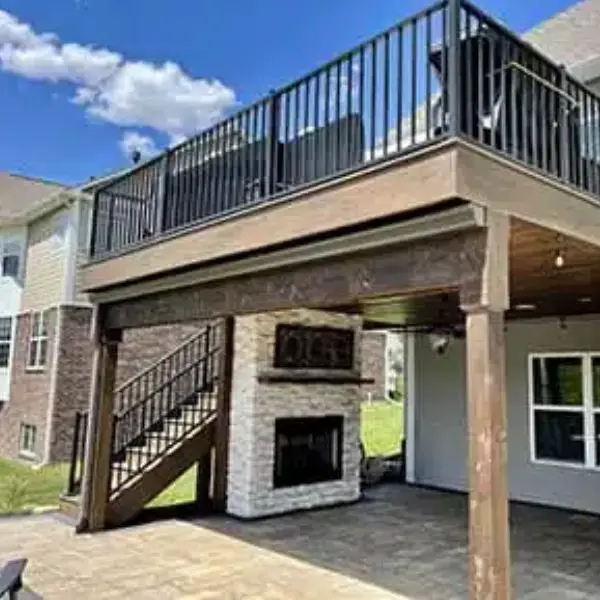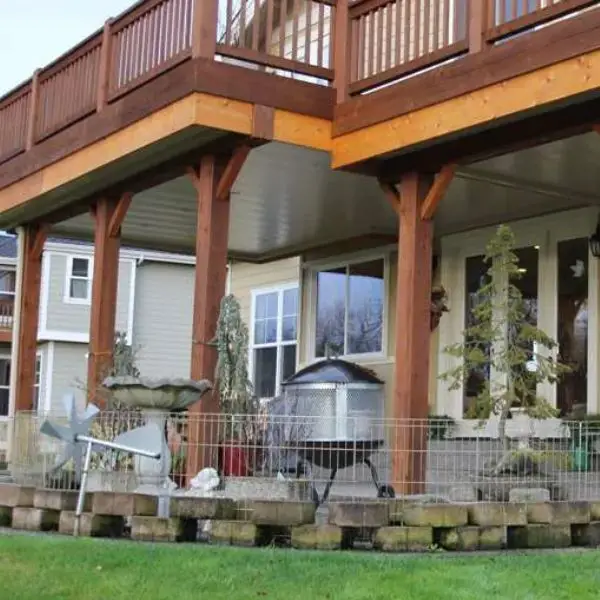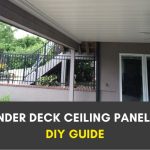As summer approaches, you might be thinking about how to keep the area under your deck dry. Waterproofing your deck is key to preventing water damage.
Water and wood aren’t a good mix, so choosing the right waterproofing method for your deck is really important.
Waterproofing under your deck involves putting panels underneath to catch and guide water away. There are several ways to do this. You could coat the deck’s surface, use flanges (which are like edges) around the deck boards, or cover it with materials like vinyl or rubber.
These methods help you enjoy the space under your deck without worrying about getting wet or the wood getting damaged.
This guide will give you all the details you need about waterproofing your outdoor area. You’ll learn the best techniques and get some helpful tips. By the end of it, you’ll know all about deck waterproofing and be ready to tackle the job with confidence.
Understanding Under Deck Waterproofing Systems
Waterproofing your deck is key to keeping the area underneath it dry and in good shape, especially in summer. Proper waterproofing is important for any deck, but especially for wood decks.
Protecting both the top and the underside of your deck is essential, especially if you have an elevated or roof deck.
Effective Methods to Waterproof Under the Deck
There are many ways to waterproof the area under a deck. You can use decking flanges to cover gaps between planks, stopping water from dripping through.
Another option is installing downspouts and deck membranes, where plastic sheets between joists create a trough to drain water away. Ceiling installations are also a stylish solution, where waterproof panels installed under the deck prevent water from reaching it.
Decking Flanges for Water Diversion
Decking flanges are useful for keeping moisture away. They fit between deck planks and act like mini gutters, directing rainwater away from the deck.
You might need to adjust the deck planks to fit the flanges, and proper installation is crucial for them to last.
Downspouts and Membrane Installation
This popular method involves plastic sheets wrapped between joists, forming a trough to redirect water. You can nail waterproof membranes to the tops of the joists and install downspouts between them.
The decking boards go on top, and you seal all joints with tape. This system channels rainwater into drains, keeping the area dry.
Ceiling Installation for Aesthetic Waterproofing
Waterproof ceilings are not only functional but also enhance the look of your outdoor space. These panels, installed under your deck, angle slightly to let water flow into a gutter system. This method is easier than membrane installation and offers a finished look.
Over-Deck Coating for Protection
Deck coatings made of materials like polyurethane or latex are applied to the deck surface. They need proper cleaning and preparation before application. These coatings are durable and come in various colors, but they can be tricky to apply and require time to dry.
Sealing for Effective Waterproofing
Sealing is a must for waterproofing under a deck. You should seal beneath door thresholds leading from the deck to inside your house. You can also use deck sealant or stain to protect the wood, though it won’t be completely waterproof.
Simple Waterproofing with Panels
Attaching corrugated panels below the deck structure is an easy and quick method. These panels catch water that slips through the cracks. Ensure they are angled for proper water drainage.
Drainage Systems for Water Management
A good drainage system is crucial, no matter the waterproofing method. Ensure there’s a gutter or drain on or near the deck. The waterproofing material should be angled to direct water into the drainage system, preventing water pooling and damage.
Vinyl Membranes for Lasting Protection
Vinyl membranes cover the deck and stop water leakage. They are a top choice for both above and below deck waterproofing and preventing wood rot. While more expensive than sealants, they don’t require frequent reapplication.
Key Points About Waterproofing Under Your Deck

Waterproofing the area under your deck involves using drainage panels to collect and redirect water. These panels can be installed above or below the deck joists, and they come in three types: ones that fit below the joists, between the deck boards and joists, and on top of the deck.
If you don’t use something like deck joist tape, water and debris can get stuck between the decking boards and joists. This can cause the wood, whether treated or untreated, to rot and weaken.
Joist tape also helps protect the metal fasteners from the corrosive effects of copper, which is used in treated wood, keeping your deck held together securely.
A good quality deck joist tape will protect important parts of your deck like the ledger board, joists, and rim joint from rot and decay.
This keeps your deck strong and saves you from costly repairs. The tape also helps seal up spaces around screws and metal parts to prevent corrosion.
How to Waterproof Under Your Deck for Storage
To make the space under your deck suitable for storage, installing an under-deck drainage system is a great solution.
This system will not only maintain the look and structural strength of your deck but also protect the space below it.
With a reliable deck drainage panel, you can use the area under your deck for storage or as an additional living space, even in rainy weather.
Easy DIY Waterproofing for Under Your Deck
Waterproofing under your deck can be a simple DIY project that saves you money. Here’s a straightforward way to do it:
Deck Drainage Panels
These are easy to install and help with proper drainage. They’re a time and money saver, especially if you’re doing it yourself.
Deck Drainage System
Think about a system that lets you add things like lights or fans under the deck. This system allows you to install electrical and gas systems safely.

Extra Tips for Better Waterproofing
Besides the basic steps, there are a few extra things you can do:
- Flashing: This is like using metal strips to seal gaps where two pieces of wood meet. It’s great for keeping water out of these spots. You’ll often find it where the deck meets other structures like roofs or chimneys.
- Caulk: Use this around the edges of the flashing to make a watertight seal. There are different types, like polyurethane or latex, and some are a mix of both. Choose based on what looks best and what you’re comfortable working with.
- Galvanized Metal Lath: This is a metal base used under hardwood decks. It helps create a strong foundation and is easy to work with.
With these steps, you can effectively waterproof the area under your deck and even add some cool features!
Final Thoughts
If you’re thinking about waterproofing under your deck, it’s important to follow the right steps. This can be a bit tricky if your deck is already built.
But if there’s enough room under your deck and it’s raised up, you can turn this space into extra storage. The problem is, when it rains, water can drip through the gaps in the deck boards and get into this area.
This water issue can be similar to what happens when water gets close to house foundations, especially if the space under your deck is partially underground. To use this under-deck area for storage, especially in places where it rains a lot, you need to make sure it’s waterproofed.
The best time to set up a good drainage system and waterproofing is when you’re first putting in your deck, but it’s still possible to do it later with some extra effort.
Hina Kanwal is the dynamic force behind Deckfaqs.com, blending her expertise in deck design with actionable insights. Known for her engaging content and practical advice, she empowers homeowners to elevate their outdoor spaces. Her passion and knowledge make her a trusted voice in the world of deck-building.







